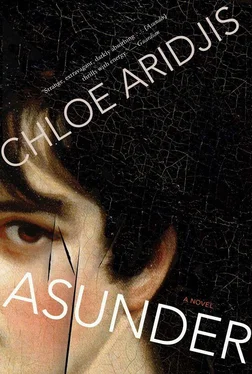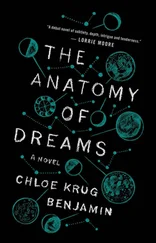At first I didn’t know which way to turn. Each student was at a different painting. The restorer took her place at the centre of the room keeping a gentle eye on things, and every now and then would smile over as if to thank me for my patience. She needn’t have, however, for I soon saw I had little to worry about. With rare restraint, the students maintained a good distance from the paintings and none held their magnifying glass too close to a surface.
As they stood happily, or perhaps anxiously, inspecting, I went through the list of cracks that had just been recited and started to envision them in the people around me.
Upon closer observation, the art restorer didn’t seem as serene as I’d first thought. She kept clearing her throat and tucking strands of hair behind her ears when none had fallen out, and I saw at the centre of her chest a concentric spiral crack, similar in structure to that of a star group, one great swirl from which the primal energy of the universe might come radiating outwards.
In the male student to her left, his narrow blue eyes squinting in concentration, I saw horizontal brushstroke cracks running across his face as if following the grooves of the brush in the paint layer, like fine currents of wind marking his cheeks.
Next, I observed a young woman in a seahorse-print dress who kept polishing her magnifying glass on her sleeve, surely something she wasn’t meant to do. On her neck, right above the collar, I located a large spoke crack, as if someone had been pressing outwards from beneath her skin.
In another girl, her bun held in place by a pencil, I saw garland cracks, small short curves disrupting the marginal areas of her face like tiny waves. In the guy next to her, whose glasses could have used a good cleaning, a grid crack divided his high forehead into right angles that ran into each other, creating little irregular boxes.
The longer I applied what I’d just heard to the living specimens around me, imagining more and more fissures in their façades, the louder these fantasies of decomposition started to gather force, like a creature that after years of slumber at the bottom of the ocean in blackish-blue darkness is nudged by a current initiated somewhere far off, possibly by a small boat skimming the surface of the water leagues overhead, and, awakened, opens an enormous eye and prepares for the next voyage.
Yet at home my miniature landscapes seemed immune to the passage of time, as if in possession of a secret formula against erosion. The moths I’d replace every couple of months but the habitats themselves hardly needed upkeep apart from some careful dusting, and I began to long for high-viscosity magma to burst through the surface of the volcano, up through the crust to force open a new path.
Once my model of the excavation was nearly complete, layers of time set in sand and superglue, I decided I would try to depict geological stages in a different way. I would replicate Pegwell Bay, but without the boy or his relatives.
After some deliberation as to how to reproduce the cliffs I found a slice of plywood, the sort used at rock-climbing centres, and coated it with non-reflective varnish to give it the illusion of age. For the shallow inlet I used a layer of dull yellow packing paper, and added a few glints of reflected sunlight with a paintbrush. Last I grafted on the sunset, the sky a sheet of carton smudged with raw umber. But the paper I’d used for the inlet wasn’t right, it wasn’t the proper tone and didn’t evoke anything, least of all an inlet on the south-eastern coast of England, so I tore it off in one go, taking along some of the rock since it had all been attached with superglue.
Over the next few days I brainstormed about what material I could use instead, what kind of paper or carton would capture the still yet not entirely flat or smooth sheet of water from which the limestone boulders emerged, a simple task yet for some reason I couldn’t think of the right material. A visit to Cass Art yielded nothing, nor a quick look in a crafts book in our museum shop. I would have to be extravagant and pay a visit to L. Cornelissen & Son in Great Russell Street.
This shop was always full of wonders: tall glass bottles of varnish, pigment and resin; apothecary jars filled with dry paint like sands from mythic beaches: Red Ochre and Manganese Blue, Cobalt Turquoise and Lapis Lazuli, Yellow Ochre and Egyptian Blue; reed pens and genuine Egyptian papyrus in case one of the mummies at the British Museum awakened with a thought; cigar-shaped pastels and labelled crayons; handmade paintbrushes the size of sceptres… After half an hour of gazing, during which I handled and considered and admired far more than I bought, I found a thin sheet of gold leaf perfect for the shallow inlet.
That night I came upon Jane and Lucian huddled close at the kitchen table, a pot of tea and an ashtray between them. Have a seat, Jane said, laughing nervously. I obliged. Lucian rolled three cigarettes, playing with the strands of tobacco before fitting them into the paper. Out of courtesy I smoked one. Jane got up and poured me a cup of tea, then asked about my week. I muttered something about Daniel at the Tate and my visit to Cornelissen’s. Lucian told me he’d sold fourteen skull rings to a group of Mexican kids in Misfits and Throbbing Gristle T-shirts. Jane told me about Funestre, a new band she’d signed. I sensed the issue of Lucian’s past had been resolved. And that they hadn’t spoken about the apparition on the balcony, or, if they had, Lucian hadn’t got the full measure of what had happened. But then again, neither had I.
I finished my tea and stood up. Lucian offered to roll me another cigarette. Jane invited me to a gig that Wednesday. No thank you, I said to both, and wished them goodnight.
In my room, door closed and at my desk, I could hear her laughter in the kitchen, gleeful but tense, and smell the smoke from Lucian’s cigarettes. Very gently I pressed my thumbs down on the gold leaf not wanting to tear it, gently gently till the surface became rippled, like a gilt shimmer on water capturing the last of the day’s sun in the low tide, clinging to those last bits of illumination.
As much as Daniel and I tried to lose ourselves in our collections, it was hard to ignore the transition from late autumn to early winter, the shifts in colour and foliage outside and the swell in numbers within. Tourist season had begun and Christmas travellers were starting to flock to our museums and with them new languages, wider than the usual repertoire, began to float through the rooms. Yet beyond those walls the days grew darker and shorter, and expressions more sullen, as a steely melancholy bit into the city.
Over the past few weeks Daniel had been working on a new collection, The Tinnitus of the Old Astronaut , which gave rise to new hopes. The handful of correspondents to whom he’d sent samples commented on the great progress he had made, and the air of dignified resignation, as they called it, of his characters, all individuals who found themselves in the twilight of their careers: the old acrobat retired to the wings, the signalman losing his sight, the dancer with a shattered ankle, the porn star with disfigured breasts, the diabetic carpenter, forty kilos overweight, straining to lift his toolbox.
It wasn’t old age that had inspired the poems, since Daniel was barely circling his mid-forties, but rather a deep weariness with regard to his own body, he said, the body he could never escape. This sense of entrapment was felt most in his limp, with which he just longed to part ways and cast off in some foreign city after dusk, but no, it was as loyal and resilient as a dog.
At least the acrobat, the astronaut, and even the porn star, he said, had been able to escape their own bodies and, for a few moments, flee their condition and enter something more hypnotic, but he had never had that, not even through his writing, for as he sat at his desk that hideous thing was still clutching at his foot and if it clutched at his foot it clutched at his mind, and he never felt entirely free. For years he had suffered the vertigo of existence, he said, but without experiencing any of its physical thrills. Even the damn contraption nailed to his living-room floor had become a problem, its sturdy wooden foot mocking him each time he walked past.
Читать дальше












